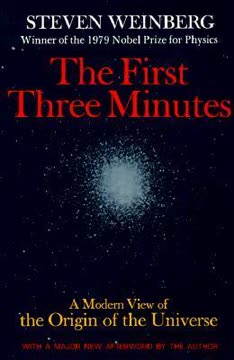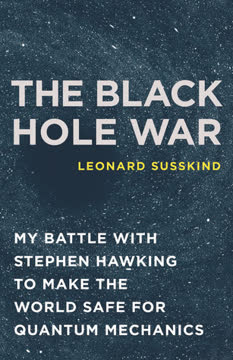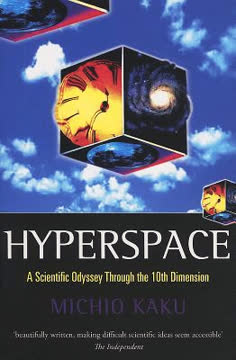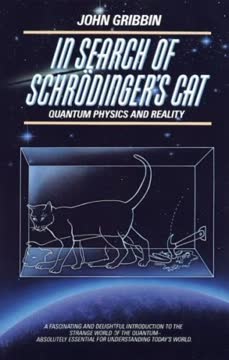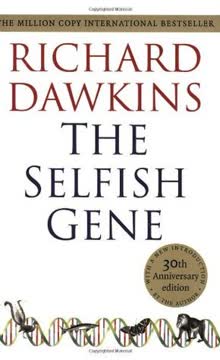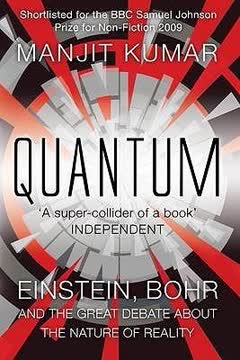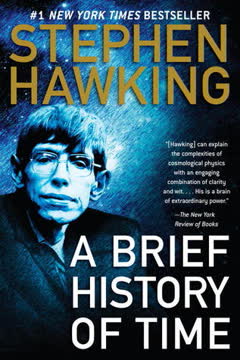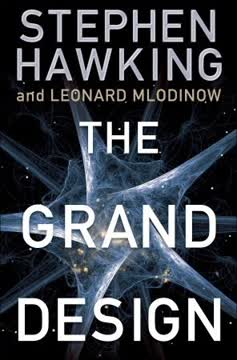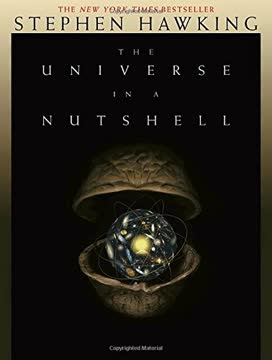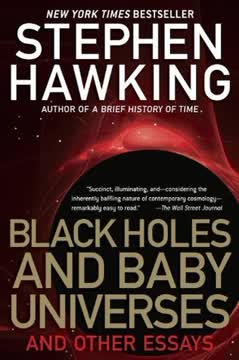Puntos clave
1. Del Mito Antiguo a la Cosmología Moderna: Nuestra Comprensión Evolutiva del Universo
Nos encontramos en un mundo desconcertante. Queremos entender lo que vemos a nuestro alrededor y preguntarnos: ¿Cuál es la naturaleza del universo? ¿Cuál es nuestro lugar en él, y de dónde venimos nosotros y él? ¿Por qué es como es?
Explicaciones antiguas: Los humanos han buscado durante mucho tiempo entender el universo, inicialmente a través de mitos y creencias religiosas. Estas primeras teorías a menudo involucraban espíritus o dioses controlando fenómenos naturales.
Revolución científica: El método científico gradualmente reemplazó las explicaciones míticas, llevando a modelos más precisos del universo:
- Aristóteles y Ptolomeo: Universo centrado en la Tierra
- Copérnico y Galileo: Sistema solar centrado en el Sol
- Newton: Leyes del movimiento y la gravedad
- Einstein: Teoría de la relatividad
Cosmología moderna: Hoy en día, tenemos una visión enormemente ampliada del universo, que abarca miles de millones de galaxias y se extiende por miles de millones de años luz. Nuestro entendimiento continúa evolucionando a través de la observación, la experimentación y el trabajo teórico.
2. La Relatividad de Einstein: Revolucionando los Conceptos de Espacio, Tiempo y Gravedad
El descubrimiento de que la velocidad de la luz parecía la misma para todos los observadores, sin importar cómo se movieran, llevó a la teoría de la relatividad y al abandono de la idea de un tiempo absoluto único.
Relatividad especial: La teoría de 1905 de Einstein introdujo conceptos revolucionarios:
- La velocidad de la luz es constante para todos los observadores
- Dilatación del tiempo: Los relojes en movimiento funcionan más lentamente
- Contracción de la longitud: Los objetos en movimiento parecen más cortos
- Equivalencia masa-energía: E = mc²
Relatividad general: La teoría de 1915 de Einstein describe la gravedad como la curvatura del espacio-tiempo:
- Los objetos masivos deforman el tejido del espacio-tiempo
- Los planetas orbitan el Sol siguiendo el espacio-tiempo curvado
- Dilatación gravitacional del tiempo: El tiempo transcurre más lentamente en campos gravitacionales más fuertes
- Fenómenos predichos: ondas gravitacionales, agujeros negros y la expansión del universo
3. Mecánica Cuántica: Revelando la Naturaleza Probabilística de la Realidad en las Escalas Más Pequeñas
El principio de incertidumbre señaló el fin del sueño de Laplace de una teoría de la ciencia, un modelo del universo que sería completamente determinista.
Revolución cuántica: A principios del siglo XX, los científicos descubrieron que las leyes clásicas de la física se descomponen a escala atómica.
Conceptos clave de la mecánica cuántica:
- Dualidad onda-partícula: Las partículas pueden comportarse como ondas y viceversa
- Principio de incertidumbre: No se puede conocer simultáneamente la posición exacta y el momento de una partícula
- Naturaleza probabilística: Solo se puede predecir la probabilidad de resultados, no resultados definitivos
- Superposición cuántica: Las partículas pueden existir en múltiples estados simultáneamente
- Entrela
zamiento: Las partículas pueden estar correlacionadas a grandes distancias
Implicaciones: La mecánica cuántica desafía nuestra comprensión intuitiva de la realidad, sugiriendo un universo fundamentalmente probabilístico en las escalas más pequeñas.
4. La Teoría del Big Bang: Rastreando el Origen y la Evolución de Nuestro Universo en Expansión
Ahora sabemos que nuestra galaxia es solo una de unas cien mil millones que se pueden ver usando telescopios modernos, cada galaxia conteniendo a su vez unos cien mil millones de estrellas.
Evidencia del Big Bang:
- Expansión del universo (Ley de Hubble)
- Radiación cósmica de fondo de microondas
- Abundancia de elementos ligeros (hidrógeno y helio)
Línea de tiempo del universo:
- 0 segundos: Big Bang
- 10⁻⁴³ segundos: Era de Planck (gravedad cuántica)
- 10⁻³⁵ segundos: Período inflacionario
- 3 minutos: Comienza la nucleosíntesis
- 380,000 años: Formación de átomos (recombinación)
- 400 millones de años: Se forman las primeras estrellas y galaxias
- 13.8 mil millones de años: Día presente
Preguntas en curso: La materia oscura, la energía oscura y el destino final del universo continúan desafiando nuestra comprensión de la evolución cósmica.
5. Agujeros Negros: Fenómenos Cósmicos Extremos Donde la Física Se Descompone
Los agujeros negros no son realmente negros después de todo: brillan como un cuerpo caliente, y cuanto más pequeños son, más brillan.
Formación: Los agujeros negros se forman cuando estrellas masivas colapsan o galaxias colisionan, creando regiones donde la gravedad es tan fuerte que nada puede escapar.
Propiedades clave de los agujeros negros:
- Horizonte de eventos: Punto de no retorno para la luz y la materia
- Singularidad: Punto infinitamente denso en el centro
- Radiación de Hawking: Emisión teórica de partículas, causando que los agujeros negros se evaporen lentamente
- Dilatación del tiempo: El tiempo se ralentiza dramáticamente cerca del horizonte de eventos
Significado: Los agujeros negros desafían nuestra comprensión de la física, ya que la relatividad general y la mecánica cuántica se descomponen al describir sus propiedades.
6. La Flecha del Tiempo: Explorando Por Qué Experimentamos el Tiempo en Una Dirección
El aumento del desorden o la entropía es lo que distingue el pasado del futuro, dando una dirección al tiempo.
Flecha termodinámica del tiempo:
- Segunda ley de la termodinámica: La entropía (desorden) aumenta con el tiempo
- Explica por qué podemos recordar el pasado pero no el futuro
- Vinculada a la expansión del universo
Otras flechas del tiempo:
- Psicológica: Percibimos el tiempo como fluyendo del pasado al futuro
- Cosmológica: El universo se expande en lugar de contraerse
Implicaciones: La flecha del tiempo plantea preguntas sobre la naturaleza de la causalidad, el libre albedrío y la posibilidad de viajar en el tiempo.
7. Unificando la Física: La Búsqueda Continua de una Teoría del Todo
Si encontramos un conjunto completo de leyes básicas, aún quedará en los años venideros la tarea intelectualmente desafiante de desarrollar mejores métodos de aproximación para que podamos hacer predicciones útiles de los resultados probables en situaciones complicadas y realistas.
Estado actual de la física:
- Modelo Estándar: Describe partículas fundamentales y fuerzas (excepto la gravedad)
- Relatividad General: Describe la gravedad y la estructura a gran escala del universo
Intentos de unificación:
- Teoría de cuerdas: Propone cuerdas vibrantes diminutas como bloques de construcción fundamentales
- Teoría M: Extiende la teoría de cuerdas para incluir múltiples dimensiones
- Gravedad cuántica de bucles: Intenta reconciliar la mecánica cuántica con la relatividad general
Desafíos: Desarrollar una teoría cuántica de la gravedad y explicar fenómenos como la materia oscura y la energía oscura siguen siendo objetivos importantes en la física.
8. El Principio Antrópico: Examinando Por Qué el Universo Parece Ajustado para la Vida
El principio antrópico débil establece que en un universo que es grande o infinito en espacio y/o tiempo, las condiciones necesarias para el desarrollo de la vida inteligente se cumplirán solo en ciertas regiones limitadas en espacio y tiempo.
Problema del ajuste fino: Muchas constantes fundamentales de la naturaleza parecen ajustadas con precisión para permitir la existencia de la vida.
Posibles explicaciones:
- Azar: Tuvimos suerte en nuestro universo
- Diseño: Un creador ajustó el universo para la vida
- Multiverso: Nuestro universo es uno de muchos, cada uno con diferentes propiedades
Implicaciones: El principio antrópico plantea preguntas filosóficas sobre la naturaleza de la explicación científica y el papel de los observadores en el universo.
9. El Futuro de la Física: Desafíos e Implicaciones de Nuestra Búsqueda de la Comprensión Última
Incluso si descubrimos una teoría unificada completa, no significaría que podríamos predecir eventos en general, por dos razones. La primera es la limitación que el principio de incertidumbre de la mecánica cuántica impone a nuestros poderes de predicción. No hay nada que podamos hacer para evitar eso.
Áreas de investigación en curso:
- Materia oscura y energía oscura
- Computación cuántica e información
- Ondas gravitacionales
- Física de partículas más allá del Modelo Estándar
Desafíos tecnológicos:
- Construir aceleradores de partículas más potentes
- Desarrollar detectores más sensibles para fenómenos raros
- Avanzar en métodos computacionales para simulaciones complejas
Implicaciones filosóficas:
- Límites del conocimiento: ¿Tendremos alguna vez una comprensión completa del universo?
- Naturaleza de la realidad: ¿Cómo se relacionan nuestras teorías con la naturaleza subyacente de la existencia?
- Papel de la conciencia: ¿Juega el observador un papel fundamental en la mecánica cuántica?
Última actualización:
FAQ
What's "A Briefer History of Time" about?
- Overview: "A Briefer History of Time" by Stephen Hawking and Leonard Mlodinow is a simplified version of Hawking's earlier work, "A Brief History of Time." It aims to make complex concepts in cosmology more accessible to a broader audience.
- Content Focus: The book covers fundamental questions about the universe, such as its origin, structure, and eventual fate, while explaining key scientific theories like relativity and quantum mechanics.
- Purpose: It seeks to update readers on recent developments in theoretical physics and cosmology, including string theory and the unification of forces.
- Approach: The authors use clear language and illustrations to explain scientific concepts, making it suitable for readers without a deep background in physics.
Why should I read "A Briefer History of Time"?
- Simplified Concepts: The book breaks down complex scientific theories into more understandable terms, making it ideal for those new to cosmology.
- Updated Information: It includes recent advancements in physics and cosmology, providing a current perspective on the universe's mysteries.
- Engaging Style: Hawking and Mlodinow use engaging narratives and analogies to explain scientific phenomena, making the learning process enjoyable.
- Broad Appeal: Whether you're a science enthusiast or a curious reader, the book offers insights into the universe's workings that are both enlightening and thought-provoking.
What are the key takeaways of "A Briefer History of Time"?
- Universe's Nature: The universe is vast, dynamic, and governed by laws that we are continually striving to understand, such as relativity and quantum mechanics.
- Scientific Theories: The book explains key theories like the Big Bang, black holes, and the expanding universe, highlighting their significance in understanding cosmic phenomena.
- Unified Theory Quest: It discusses the ongoing quest for a unified theory that combines all fundamental forces of nature, including gravity, electromagnetism, and nuclear forces.
- Role of Time: Time is not absolute but relative, intertwined with space, and affected by gravity, challenging our traditional perceptions.
How does "A Briefer History of Time" explain the Big Bang theory?
- Origin of the Universe: The Big Bang theory posits that the universe began as a singularity, a point of infinite density and temperature, about 13.7 billion years ago.
- Expansion: Following the Big Bang, the universe expanded rapidly, cooling as it grew, leading to the formation of fundamental particles and eventually atoms.
- Cosmic Microwave Background: The book explains how the residual radiation from the Big Bang, known as the cosmic microwave background, provides evidence for this theory.
- Inflationary Model: It introduces the concept of inflation, a rapid expansion that smoothed out the universe's initial irregularities, leading to the large-scale structure we observe today.
What is the significance of black holes in "A Briefer History of Time"?
- Definition: Black holes are regions in space where gravity is so strong that nothing, not even light, can escape from them.
- Formation: They form when massive stars collapse under their own gravity, creating a singularity surrounded by an event horizon.
- Scientific Importance: Black holes challenge our understanding of physics, particularly in the realms of general relativity and quantum mechanics.
- Research and Observation: The book discusses how black holes are studied through their effects on nearby matter and radiation, providing insights into the universe's extreme conditions.
How does "A Briefer History of Time" address the concept of time travel?
- Relativity and Time: The book explains how Einstein's theory of relativity allows for the possibility of time travel, at least theoretically, by affecting the flow of time.
- Wormholes: It introduces the concept of wormholes, hypothetical passages through space-time that could potentially allow for travel between different points in time.
- Scientific Challenges: While time travel is a popular science fiction theme, the book discusses the scientific challenges and paradoxes, such as causality issues, that make it unlikely with current understanding.
- Chronology Protection: Hawking's idea of chronology protection suggests that the laws of physics may prevent time travel to avoid paradoxes, maintaining the universe's logical consistency.
What role does quantum mechanics play in "A Briefer History of Time"?
- Fundamental Theory: Quantum mechanics is presented as a fundamental theory that describes the behavior of particles at the smallest scales, where classical physics fails.
- Uncertainty Principle: The book explains Heisenberg's uncertainty principle, which states that certain pairs of properties, like position and velocity, cannot be simultaneously known with precision.
- Wave-Particle Duality: It discusses the dual nature of particles, which exhibit both wave-like and particle-like properties, challenging traditional notions of matter.
- Quantum Gravity: The quest for a quantum theory of gravity, which would unify general relativity and quantum mechanics, is highlighted as a major goal in modern physics.
How does "A Briefer History of Time" explain the unification of forces?
- Four Fundamental Forces: The book outlines the four fundamental forces: gravity, electromagnetism, the weak nuclear force, and the strong nuclear force.
- Electroweak Unification: It describes how the electromagnetic and weak nuclear forces have been unified into a single electroweak force at high energies.
- Grand Unified Theories (GUTs): The book discusses attempts to unify the electroweak force with the strong nuclear force, though gravity remains separate.
- String Theory: String theory is introduced as a potential framework for unifying all forces, suggesting that particles are one-dimensional strings rather than point-like entities.
What are the best quotes from "A Briefer History of Time" and what do they mean?
- "The boundary condition of the universe is that it has no boundary." This quote reflects the idea that the universe is self-contained and finite, yet without edges or singularities, challenging traditional concepts of beginnings and endings.
- "We see the universe the way it is because we exist." This statement encapsulates the anthropic principle, suggesting that the universe's conditions are such that they allow for the existence of observers like us.
- "Equations are more important to me, because politics is for the present, but an equation is something for eternity." This quote from Einstein, included in the book, highlights the timeless nature of scientific discovery compared to the transient nature of human affairs.
- "If we find the answer to that, it would be the ultimate triumph of human reason—for then we would know the mind of God." This reflects Hawking's view that understanding the universe's fundamental laws would be akin to understanding the divine, emphasizing the profound nature of scientific inquiry.
How does "A Briefer History of Time" address the concept of a unified theory?
- Ultimate Goal: The book presents the search for a unified theory as the ultimate goal of physics, aiming to explain all fundamental forces and particles within a single framework.
- Historical Context: It traces the history of attempts to unify forces, from Newton's laws to Einstein's relativity and beyond, highlighting the progress and challenges faced.
- Current Theories: String theory and supergravity are discussed as leading candidates for a unified theory, though neither is complete or fully proven.
- Philosophical Implications: The pursuit of a unified theory raises philosophical questions about the nature of reality, the role of a creator, and the limits of human understanding.
What is the significance of the anthropic principle in "A Briefer History of Time"?
- Definition: The anthropic principle suggests that the universe's laws and constants are as they are because they allow for the existence of observers like us.
- Weak vs. Strong: The book distinguishes between the weak anthropic principle, which applies to specific regions of the universe, and the strong anthropic principle, which posits multiple universes or regions with varying laws.
- Implications for Science: It challenges scientists to consider why the universe's conditions are just right for life, influencing theories about the universe's origin and structure.
- Criticism and Debate: The anthropic principle is controversial, with some viewing it as a tautology or a philosophical rather than scientific explanation.
How does "A Briefer History of Time" explain the nature of scientific theories?
- Model of the Universe: A scientific theory is described as a model that explains a wide range of observations and makes predictions about future events.
- Provisional Nature: The book emphasizes that scientific theories are always provisional, subject to revision or replacement as new evidence emerges.
- Criteria for Good Theories: A good theory should be simple, consistent, and able to make testable predictions, allowing it to be falsified if incorrect.
- Role of Theories: Scientific theories help us understand the universe's workings, guiding research and expanding our knowledge of the natural world.
Reseñas
Una Breve Historia del Tiempo es ampliamente elogiada como una introducción accesible a conceptos complejos de la física para no científicos. Los lectores aprecian las explicaciones claras y el entusiasmo de Hawking, aunque algunos encuentran partes desafiantes. El libro abarca temas como la relatividad, la mecánica cuántica y la cosmología. Muchos críticos lo recomiendan para aquellos curiosos sobre el universo, señalando que despierta asombro y amplía la comprensión. Algunos sugieren que es más adecuado para estudiantes de secundaria o adultos que buscan una visión general básica de las teorías modernas de la física.
Similar Books

